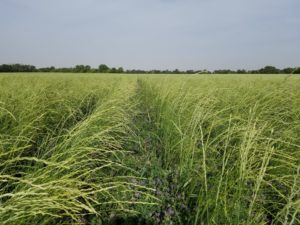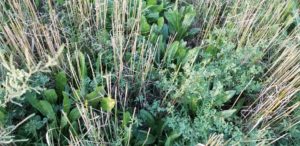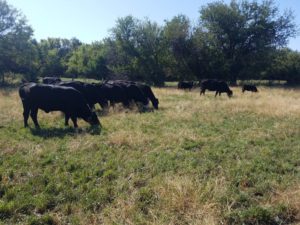Interview with Sustain-A-Grain
An Interview with Brandon Kaufman of Sustain-A-Grain LLC
This interview is part of a series that highlights the work of various individuals and organizations within the Kernza® network. Through these interviews, we aim to share and celebrate that there is a large and ever-changing ecosystem that moves Kernza® perennial grain forward. If you would like your organization’s work to be featured in an interview, please email Sophia Skelly. To learn more about the Kernza® network, visit our directory.
Can you tell me about Sustain-A-Grain and how Kernza® fits into your operation?
Working in production agriculture, I quickly learned that I had to find a way to be different, to set myself apart. If we all play basketball like Shaquille O’Neal, the biggest guy is gonna win. How am I going to be profitable and sustainable? How can I sustain my family on fewer acres? I realized that I really had to find my niche. So I started experimenting. I’ve been growing triticale, rye seed, non-GMO soybeans, non-GMO corn, and sunflowers, to name a few.
A friend of mine introduced me to Kernza® and we started Sustain-A-Grain. My friend asked me, “Why do you guys plant corn every year?” And I said, “I don’t know. That’s just what we do.” And one of the things that is always stressful in agriculture is getting things seeded. When you’re seeding every year, you have to grapple with the risk of too much rain or too little rain. Establishment with Kernza® really takes care of all that. You have the first year, which is the establishment year. After that, it’s there for years to come.
I’m also excited to grow Kernza® because it’s just a huge opportunity. We’re in an early adopters phase and how it grows in the next decade is going to be the entire perennial cropping system. So that’s why Sustain-A-Grain got started; we’re trying to collaborate with other growers and create a database for how to grow it. It’s very much a chicken and the egg situation. The markets aren’t really there, because there’s not enough production. And nobody really knows if there’s a buyer at the other end. People keep asking if we have it figured out and the answer is no. But we do know enough things to know that we shouldn’t wait.
What does that collaboration with other Kansas farmers look like? How do people find out about Kernza®?
We reached out to a small group of growers and a few of them reached out to us. It goes both ways. We don’t always do a lot of outreach. People aren’t going to change until it’s affecting their pocketbook; they’re not going to change their ways until they absolutely have to. At the same time, I don’t think Kernza® is for everybody. There’s no safety net right now and it’s not easy. It’s important to consider who can withstand the risks involved and endure the hardships during the learning years.
At Sustain-A-Grain, we don’t have all the answers, but we do have the infrastructure ready and we’re in a central location. Not everybody should have to figure out the handling, cleaning and de-hulling processes. If we can take some of that off their hands, and share what we have learned, then that’s great. The collaboration is really important. We can make a really long list of what not to do in the first 12 months, which can save other farmers a lot of headaches.
 Farmers around the country are interested in growing Kernza® perennial grain for a number of reasons. Can you talk about why Kansas growers are interested in incorporating it on their farms?
Farmers around the country are interested in growing Kernza® perennial grain for a number of reasons. Can you talk about why Kansas growers are interested in incorporating it on their farms?
There’s a lot of time being spent on organic versus non-organic and perhaps we shouldn’t be looking at it that way. We should be relishing the fact that we’ve got a perennial grain and that we can integrate livestock on this perennial, and we can sequester carbon with this perennial. At some point, we’re going to have to pick our poison– whether we want to optimize the soil tillage or use a synthetic — which disturbance do we want to pick? I think: to each their own. If we go 20 miles east of where I am right here, we have about five inches of topsoil left. If we lose any more soil, we’re not having the conversation about organic versus conventional because there’s no more soil. At that point, we’re geologists. So in some places, I can’t even have the tillage conversation, because we just cannot lose any more soil.
In some places, I can’t even have the tillage conversation, because we just cannot lose any more soil.
In terms of the perennial mentality, I think we’re just tapping into it. I think that in our lifetime, annual monocultures will not be a mainstay. Maybe we will see annual polycultures. Right now, we’re still trying to figure out a perennial monoculture but, of course, the best would be perennial polycultures. We are working towards that Holy Grail of perennial polyculture, through inter-seeding clovers and chicory and several types of alfalfa with Kernza®. Also a part of this picture are annuals that re-seed themselves, rather than having to purchase seed every year.
I think it’s important to note that when we first settled these lands, the farmer was able to make a living. Farmers maintained a vast majority of the pie for themselves. The way agriculture has gone, the farmer has taken more and more risk on and the amount of pie left for the farmer is next to nothing. Kernza® really allows us to reset that and potentially maintain more for the producer. With Kernza®, we’re not buying seed every year. You’re not buying steel and equipment and being enslaved to all of these inputs because of the opportunities they currently provide.

What are some challenges involved with growing Kernza® perennial grain?
I think pre-conceptions are the number one challenge. You have to go in with an open mind. You can’t anticipate how the grain functions; you can’t expect the grain to flow a specific way or be harvested in a certain way.
The challenge is providing a hub of information and knowledge. I think Sustain-A-Grain fills that role here in Kansas. In the upper Midwest, they have a really good database and center for collaboration. But Kernza® was really brought to life here in Kansas and we don’t have DON issues here. In Minnesota and Wisconsin, they’re blessed with a lot of rain. In Kansas, we’re blessed with not having any disease issues, so far.
We’re also doing some experiments with canopy growth and looking at the kinds of environments Kernza® is capable of being productive in. Also, what is the definition of productive? You have to look at land values. In certain parts of the country, Kernza® is going to be a whole lot more productive just because of the climate and soil type. But those places usually have the highest land costs. In Kansas, we might not get as much production, but many producers still have livestock, unlike guys in the corn and soy dominated regions. I think integration of livestock and using Kernza® as the keystone species, and then bringing all these other parts together is going to be really important.
Who else do you collaborate with in the Kernza® world?
We coordinate with Tessa Peters and Lee DeHaan at The Land Institute. It’s important to note that we’re not necessarily working on the research side of things. We are doing trial and error on a production scale. We’re doing research on the real world situation, not on a 20 by 20 plot. I planted a 93-acre field this year, which is a pretty big leap of faith. It shows that we have confidence, even though there aren’t as many clear guidelines for growing Kernza® as there are for the common annual crops.
Looking into the future, do you have any specific plans or aspirations related to Kernza® perennial grain?
We are just thinking about how we can commercialize at scale. It’s the chicken and the egg issue we’ve been having for two years now: production and scale. It would be exciting to know that you have a year’s supply and make sure that production is happening in various regions so that you can manage your risk. What we are really aiming for in the coming years is market stabilization.
Photos courtesy of Brandon Kaufman